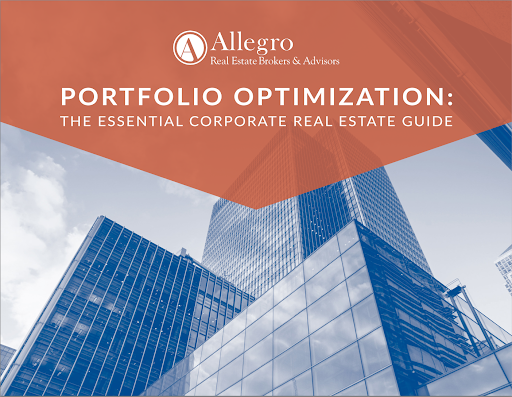During the real estate portfolio optimization process, it’s not uncommon for CRE portfolio owners to realize one or more of their assets has become unsupportive. In other words, the property or properties no longer add value to their business.
Can you relate?
Whether you’re looking to create short-term cash flow, reduce operating expenses, or simply realign your portfolio, it may be time to address your unsupportive assets with a disposition strategy. Continue reading to learn more about six different types of CRE disposition strategies.
The CRE Disposition Process In Review
In commercial real estate, the disposition process is the act of selling, subleasing, or negotiating a lease buyout of commercial real estate property. CRE portfolio owners typically turn to disposition to redistribute funds into the company or pay off debt. Oftentimes, businesses will divest of unsupportive property because it’s no longer valuable to business objectives.
There are five phases of CRE disposition:
- Strategy and initial pricing.
- Due diligence and final pricing.
- Marketing.
- Negotiations.
- Closing.
To learn more about the disposition process as a whole, take a look at this blog post.
What’s Involved In the Strategy and Initial Pricing Phase?
In the first phase of the disposition process, CRE portfolio owners work hand-in-hand with a trusted real estate advisor to outline a preliminary disposition strategy.
This strategy is achieved by:
- Confirming your disposition objectives.
- Collecting any available property data and identifying factors that may prevent you from disposing of the asset.
- Conducting initial market research to better understand your property’s standing in the marketplace.
- Developing an action plan that clearly aligns with the objectives you initially outlined.
6 Disposition Strategies to Consider
When it comes time to dispose of unsupportive assets within your real estate portfolio, know that you have options. To decide which strategy is best for your situation, consider your goals of this real estate transaction, market conditions at the time of sale, and the property type. Your real estate broker should be able to guide you through this decision-making process.
1. Traditional Sale
A traditional sale is the most common option for disposition. In this type of sale, the seller and the brokerage representative agree on a price, market the property, procure a preferred buyer, and a sale is made. The buyer is a third party and relies on a lender to finance the property for their own commercial pursuits.
2. Sell Property with Seller Financing
Sometimes, buyers are interested in your property, but unable to get lender or third party support. In this case, the seller finances the property and the buyer makes payments to the seller over an agreed upon period of time. In this instance, the seller won’t receive one lump sum at the time of sale, but will instead receive monthly payments. The advantage to this strategy? As a seller, you will earn interest on the loan and could potentially end up earning more money over time. However, the seller is bearing the risk that the buyer defaults on the loan.
3. 1031 Exchange
Some sizable sales come with equally large tax bills attached. To defer capital gains tax, the seller can enter into a 1031 exchange. A 1031 exchange enables sellers to defer their taxes on a sale as long as proceeds are “exchanged” and a replacement property is acquired and considered “like-kind.” Working with a real estate broker helps ensure that the seller follows all rules and regulations completely to avoid legal issues.
4. Auction the Property
While not as common as other options, the seller may auction their property in an effort to entice potential buyers. This approach mostly prioritizes speed over price and may require more marketing dollars spent in the short term to ensure potential buyers show up to bid.
5. Call for Offers
This strategy is often used when the seller knows there is a pool of interested and capable buyers, essentially creating a “closed bid” environment. The seller reviews all offers on a set final bid date, then chooses the best offer.
6. Market Property Without an Asking Price
Sometimes, potential buyers would prefer to visit the property before discussing a price—listing a price may actually deter these buyers from venturing further into the evaluation process. In fact, there’s evidence that sellers earn more on a commercial real estate sale when they don’t list a price. Thus, you could choose to market your property without an asking price.
Divesting unsupportive assets is often the last step for CRE investments, but can provide business leaders with a more immediate opportunity to create cash flow, reduce operating expenses, and/or alleviate liabilities.
Identify Your Unsupportive Assets Through CRE Portfolio Optimization
Corporate real estate optimization is fundamental to achieving your business goals and responding to new challenges. Learn more about assessing your existing portfolio and identifying unsupportive assets by downloading our free guide, Portfolio Optimization: The Essential Corporate Real Estate Guide.







